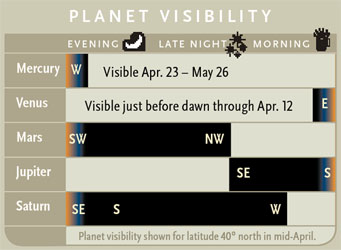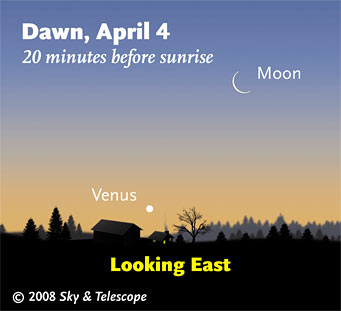Did you know that Venus is still visible in the morning sky? I have it on the best authority. There's a chart showing planet visibility in the middle of every issue of Sky & Telescope, and the one on page 47 of the April issue says that Venus is visible just before dawn through April 12th.

S&T Illustration
But wait a second! Things can't be as simple as that. Venus barely changes from day to day, so it can't just sit there in plain view on the 12th and disappear completely on the 13th. The transition must be subtle.
Moreover, any planet's visibility depends on your latitude, the clarity of the air, your level of experience, and the equipment that you use. Just what does this chart mean when it says Venus is visible?
As author of the chart, I can answer those questions. First of all, we're talking about visibility to the unaided eye. With a telescope, you can see all the bright planets just about any time they're above the horizon when the sky is clear — even during broad daylight.
And unless otherwise stated, all articles and diagrams in our magazine are intended to be precisely accurate for the "S&T standard location: 40° N, 90° W, 55 miles southwest of the proverbial Peoria, Illinois.
Finally, I know perfectly well that visibility isn't an either/or situation, but I have to put down some date. I have a formula based on a planet's brightness and its altitude above the horizon at the beginning or end of civil twilight that predicts when it should be visible to an experienced observer with good-to-excellent conditions. And I'm constantly tweaking this formula based on my own and other people's observations.

S&T Illustration
That's where you come in. My formula predicts that Venus should be visible very low in the east 15-20 minutes before sunrise through mid-April. Please go out, look for yourself, and report any positive or negative sightings to us. The key to a successful observation is finding a location with a completely unobstructed eastern horizon. And binoculars are extremely helpful, because Venus is bright and bold in binoculars even when it's barely visible to the unaided eye.
The morning of Friday, April 4, is a particularly good oppoprtunity, because Venus will be right next to a thin crescent Moon.
Please submit any reports as comments to this article or e-mail them to [email protected]. Include your location, the sky conditions, and the time accurate to one minute.
For instance, I went to my local park (42.1° N, 71.1° W) on the morning of Wednesday, April 2nd. The sky was clear though slightly hazy, with a few wispy clouds to the east. I found Venus in binoculars at 6:03, and it was consistently visible to the unaided eye from 6:05-6:10 — though pretty faint and subtle. I caught my last naked-eye glimpse at 6:20, just before I left, but by that time I was seeing it less than 5% of the time. It was still bright and bold in binoculars, and no doubt would have stayed that way until sunrise.
Incidentally, I was also following Jupiter, far off to the south. It was still quite obvious to the unaided eye at 6:20 — as long as I looked in exactly the right spot. I lost track of Jupiter once and spent several minutes searching for it with binoculars.
And two last questions — which you're also welcome to answer in e-mail or (better) as a comment to this article. Our planet-visibility chart is intentionally optimistic; it says when planets are likely to be visible — even if just for a few minutes — given ideal circumstances. Does this lead to unrealistic expectations? Would you prefer to know only when the planets are likely to be easy to see?
Finally, do you like the format of the planet-visibility chart? Does it tell you everything that you need to know? How would you like to see it changed, if at all?
 4
4









Comments
Indigo_Sunrise
April 3, 2008 at 10:09 am
In answer to your questions:
Does this lead to unrealistic expectations? It might, but mainly for amateurs, IMO.
Would you prefer to know only when the planets are likely to be easy to see? No, where's the fun in that?!? 🙂
And barring any uncooperative weather tomorrow, I'll be looking for Venus.
You must be logged in to post a comment.
SteveN
April 4, 2008 at 10:34 pm
How about some one letter codes for the visibility when it's "Easy", "Requires Optical Aid", "Requires Clear Horizon", etc.
You must be logged in to post a comment.
Anthony10307
April 5, 2008 at 5:40 am
This theory can really be put to the test on the evening of September 1st, when a waxing crescent moon, Mercury, Venus, Mars and Saturn will all be within a few degrees of each other, very low in the west just after sunset.
You must be logged in to post a comment.
Tony Flanders
April 7, 2008 at 7:08 am
I've received many reports of Venus sightings by e-mail, as well as the direct responses shown above. Just about everyone who looked for Venus found it, and most people agree that the level of optimism of the current planet-visibility chart is just about right.
The southernmost sighting came from Santiago de Cali, Colombia, where Venus was quite high in the dusk. The northernmost came from Milan, Italy, where Venus was spotted naked-eye 2.5 degrees above the horizon just 10 minutes before sunrise. According to my current formula, this sighting was really pushing the limits of possibility.
You must be logged in to post a comment.
You must be logged in to post a comment.